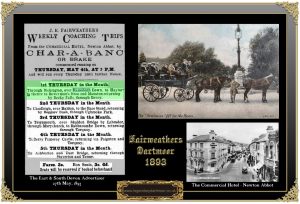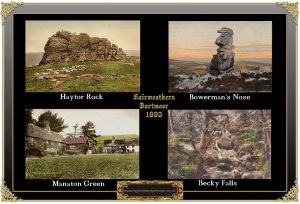
“A few minutes before three o’clock on Thursday afternoon we presented ourselves at M.r Fairweather’s Commercial Hotel, preparatory to a Char-a-banc trip over the moor. This was the opening day for the summer season. The “Newtonian” and four fine steeds as even a country squire could wish for, all in charge of Pearse, a smart and cheerful whip, were awaiting the start outside the hotel. A few minutes later some score of passengers including Mr. and Mrs Fairweather, were comfortably seated, buoyant in spirits and full of lively anticipation. As soon as Mr. Fairweather gave the signal “all-right,” Pearse responded by giving the professional smack of the whip, and away the horses merrily trotted up Courtnay Street, sweeping around the Globe Hotel with that ease and grace that assured every one the reigns had been entrusted to the safest of whips. The sun was shining with all its splendour, and wafted by a soft and refreshing breeze, which made itself perceptibly agreeable as we quitted the town, the drive became sublimely delightful. The roads on either side, on, to and through Bickington and over Ramshorn Down were profusely bedecked with bloom, the hawthorn, which seemed to reign triumphant all along the route, imparting a perfume which fairly captivated the ladies who graced our company. We have joined scores of similar outings in our day, but never before do we remember seeing the hedges, hedgerows, and orchards so resplendent in their floral garb. Amid all these glories of nature’s fairest beauties we revelled in delight. The soul seemed moved nearer its hopeful home.
Passing over Ramshorn Down the cuckoo bid us welcome with his springlike notes. Here, the scenery became varied and imposing, and as we reflected and compared the landscape before us with that of Gloucester, which we traversed through on our way to Birmingham on the previous Monday, we could not help exclaiming, ” What a contrast”! No wonder tourists from all parts proclaim “Mid-Devon the garden of England”. Reaching the nearest road-point at the foot of Haytor Rock, most of the passengers alighted from the char-a-banc and repaired thereto on foot. The rock, 2,000 ft. above sea level, is situated on the south eastern frontier of the moor. It is by no means an easy task, especially for ladies, to ascend the summit of the rock. Once there, however, one is amply repaid for the adventure. for here are the remains of rock basins. The largest is of an elliptic form about two and a half feet in diameter, with one edge much lower than the other. Many a visitor here, too, anxious to immortalise himself on the rock of fame, had engraven his name in the granite, but time and weather seemed already to be defeating his object. We beg pardon, but we would venture to suggest to those who wish to immortalise themselves, to advertise their names in the Advertiser. Their object then, we hope, would be achieved. Here with the sun pouring its soft rays on us, we were enchanted by some splendid and diversified views. Though a haze prevailed, indicative of continued fine weather we were enabled by the aid of a field glass kindly lent us by one of the party, to unveil much that was distant and interesting. On one side the whole of the beautiful garden of South Devon, intersected with charming streams and rivers, having towns, villages, and gentlemen’s seats, including Stover intermingled and bounded by the sea. In another direction the scenery presented a wide expanse of barren moor as far as the eye could reach, only interrupted with bold and mountainous tors, some of them surmounted with dark and huge masses of granite, pile upon pile, forming all sorts of grotesque and romantic shapes. In close proximity are located Saddle Tor and Rippon Tor, the latter quite 50 feet higher than Haytor, and probably the highest elevations in the county. In a westerly direction, and not far distant are situated the Haytor quarries whence the granite for construction of London Bridge was taken. For the removal of the stone a granite tramway had been laid down as far as Teigngrace, where it was placed on board barges, conveyed to Teignmouth and transferred to vessels for transit to London. The late Mr. George Templar, who also built Stover House as a residence for himself, was the founder of this tramway, but we believe it never paid for doing.
Returning to the char-a-banc we drove on by Edge Barton, formerly residence of Mr. Riley, a sportsman of some repute, to Manton. All along the scenery was superb- for ever changing, for ever enchanting. At a distance, Bowerman’s Nose stood out prominently. This huge boulder, formerly regarded as a rock idol, has evidently been formed by natural weathering of the granite. Its cognomen of Bowerman is derived from a person of that name, who is said, to have lived at Houndtor in the Conqueror’s time. This boulder is composed of layers, the topmost stone being a single block, the whole giving a facial resemblance of a man’s nose.
It was here that reaching Manaton a halt was made. This is one of the most picturesque and quaint villages in Devon, numerous as they are. In front of the Post Office and Mr. Winser’s Half Moon Inn the two adjoining, is a sort of triangular green, whereupon children can besport themselves after their own fashion and inclination. Naturally enough, most of us repaired to the Half Moon Inn for refreshments and it is only fair to say of the obliging host we were supplied with liquors of the very best quality. Here, too, we found the village blacksmith, Harry Rabjohn, sitting among his fellow workers after the day’s labour was over. Harry Rabajohns was in touch with us the very moment we entered the inn. He could crack a joke with a good honest laugh that would impart to it a hundred percent interest:- talk of moor lore, ghosts and goblins, and past times including wrestling in which days gone by he had frequently figured as a deadly opponent. His fine physique, his broad open countenance, the interesting twinkle in his eye, and, above all, his self-assurance made hims host in himself. It was with regret we had to bid him and his fellow workmen adieu.
Regaining our seats on the char-a=banc we drove through wooded scenery to Becky Falls, about a mile distant. Here, another halt was made. The Falls were explored with unabating interest. They comprised at one time one of the most beautiful cascades in the West. But now they have been robbed of much of their grandeur through a portion of the stream of water having been diverted into another channel for other purposes. Still, the little streamlet which wended its way over a precipice some 70 or 80 feet high, among giant granite boulders, sufficed to suggest the majestic scene when swelled into almighty river.
The next stage of the journey was to Bovey Tracy, where we halted at Mr. and Mrs. Hellier’s Dolphin Hotel. Mr. and Mrs. Hellier and their predecessor Mr. Joll extended to us a hearty greeting. Everyone having again refreshed themselves, the homeward journey was resumed, reaching Newton just before nine, one and all, having enjoyed one of the best afternoon’s outings ever in the merry month of May. Mr. Rogers, Newton Postmaster, on behalf of the party, heartily thanked and complimented Mr. Fairweather on the great success that attended his efforts in providing Newtonians with such facilities for exploring the lovely scenery of the neighbourhood. We may add that Mr. Fairweather has arranged to run his char-a-banc every Thursday afternoon, each week taking different routes. For next week’s route &c. see advert.” – The East & South Devon Advertiser, May 6th 1893.
I think it fair to say that today this excursion route by car would be sadly lacking the gentile speed this charabanc would have trundled along. Therefore the sights, smells and outdoor experience would have been greatly enhanced. It is also interesting to note that as the above advert for this tour shows the basic cost of the trip in 1893 would have been three shillings. According to the Bank of England’s inflation calculator would equate to the equivalent of £6.47 p. in 2019 money. Considering this party would have spent six hours on the route it would be a bargain today. As with many of these early descriptions the facts are sometimes slightly outdated and in this case no way is Rippon Tor – “probably the highest elevations in the county,” it’s High Willhays. Additionally the estimated height of Haytor at 2,000 ft. it way off the 1,400 odd feet of today.
 Legendary Dartmoor The many aspects past and present of Dartmoor
Legendary Dartmoor The many aspects past and present of Dartmoor



